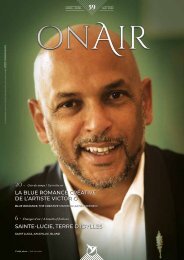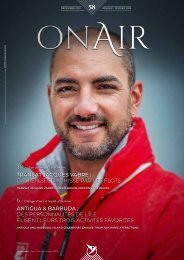You also want an ePaper? Increase the reach of your titles
YUMPU automatically turns print PDFs into web optimized ePapers that Google loves.
Cultures autochtones • Indigenous Cultures / Changer d’air<br />
1 2<br />
Autrefois appelés Emérillons, les ancêtres des teko, au<br />
cours de leur migration d’Est en Ouest, ont laissé une<br />
trace indélébile dans la toponymie de l’intérieur guyanais :<br />
un sentier connu de tous sous le nom de Chemin des émérillons.<br />
Ainsi des familles teko ont été éparpillées sur le sol<br />
guyanais. Certaines se sont retrouvées au village Kayodé<br />
entre le 04 et le 07 août dernier autour de la danse traditionnelle<br />
Tadzau ou danse du cochon-bois. Une danse<br />
marathon qui a débuté le vendredi 5 août vers 18h et a duré<br />
jusqu’au samedi 06 août à 6h du matin, pour une reprise à<br />
la mi-journée du samedi pendant presque trois heures.<br />
Plus qu’une danse, c’est une allégorie du mythe fondateur<br />
de la nation teko qui est racontée à travers les chants, les<br />
musiques aux sons du tule (flûte) et des kaway (sonnailles<br />
attachées aux pieds), les pas de danse et les habits. Une<br />
histoire codifiée. Cette rencontre était aussi un moyen de<br />
regrouper des familles teko - seul peuple autochtone uniquement<br />
présent en Guyane et nulle part ailleurs dans les<br />
Amériques -, de ressouder les liens entre générations et<br />
de partager la culture Teko avec les frères autochtones<br />
Wayana/Apalaï du Haut-Maroni.<br />
Pour les Teko, la danse est un moyen de communiquer<br />
avec les ancêtres et les grands esprits des animaux. A l’origine<br />
de cet évènement, il y a l’association Akanta dirigée<br />
par Jammes Panapuy et le groupe de danse de son père,<br />
Joachim Panapuy, Teko Makan de Camopi. Les Panapuy,<br />
une famille ancrée dans la défense et la préservation de la<br />
culture traditionnelle Teko.<br />
Depuis le mois d’avril, l’association Akanta a pu mettre sur<br />
pied des ateliers pour la préparation et la transmission d’un<br />
grand nombre de savoirs autour de la danse à Camopi :<br />
confection des habits traditionnels, pas de danse, fabrication<br />
d’instruments de musique, fabrication de tulé, la flute<br />
traditionnelle. Une vingtaine de danseurs et danseuses<br />
ont pu être formés et participer à cet échange sur Kayodé.<br />
Dans le cas du peuple Teko, la pratique culturelle de<br />
The Teko ancestors, during their migration from the east to<br />
the west, left an indelible trail on the interior toponymy of<br />
Guiana: a trail known as the “Chemin des Emérillons.”<br />
This is how the Teko families became scattered on the<br />
Guianese land. Certain of these families gathered together<br />
at the village of Kayodé on August 4-7, 2022 for a<br />
celebration of the traditional Tadzau dance, or the dance of<br />
the peccary pig, with a dance marathon starting at<br />
approximately 6pm on Friday, August 5 and continuing<br />
until 6am Saturday morning, only to start up again at<br />
midday on Saturday for almost three more hours.<br />
It’s an allegory of the myth about the founding of the Teko<br />
nation told through songs, music set the sound of the tule<br />
(flute), and kaway (bells attached to the feet), as well as<br />
the dance steps and clothing. This gathering was also a<br />
means of regrouping the Teko families—the only indigenous<br />
group uniquely found in Guiana, and no place else in the<br />
Americas—and to establish links between the generations<br />
and to share the Teko culture with their indigenous brothers,<br />
the Wayana/Apalaï of Haut-Maroni.<br />
For the Teko people, dance is a means of communicating<br />
with their ancestors and their spirit animals. The event was<br />
organized by the association, Akanta, run by Jammes<br />
Panapuy, and the dance group Teko Makan, from Camopi,<br />
led by his father, Joachim Panapuy. The Panapuy family is<br />
instrumental in the protection and preservation of the<br />
traditional Teko culture.<br />
Since the month of April, the Akanta association was able<br />
to organize ateliers to prepare for this event, which also<br />
serves as a means of sharing and transmitting a great deal<br />
of knowledge about the Camopi dance: making the<br />
traditional costumes, fabricating the musical instruments,<br />
including the “tulé,” or traditional flute. Twenty or so<br />
dancers were trained to participate in this cultural<br />
exchange at Kayodé. For the Teko people, the dance itself<br />
has undergone large changes, but is still practiced by<br />
Légendes : 1. Le drapeau des 6 nations autochtones flotte au dessus de Kayode 2. La nation teko réunie à Kayode<br />
Crédit photo : © Pascal Vardon, Emmanuelle Renard et Jean-Maurice Montoute<br />
onAir 61<br />
29

















